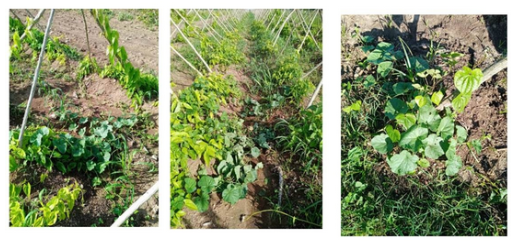Cucumis dipsaceus Ehrenb. ex Spach. new host of Meloidogyne sp. in Cuba
Main Article Content
Abstract
The objective of this research was to determine the presence of Meloidogyne species on Cucumis dipsaceus Ehrenb. ex Spach. growing as weed in a yam (Dioscorea sp.) field. Samples of C. dipsaceus plants with root galling were taken from yam areas of the National Institute of Tropical Roots and Tubers (INIVIT), Santo Domingo, Villa Clara province, located at coordinates (22.35º N; 80.13º W), Cuba. At the nematology laboratory of the institute, the perineal patterns of twenty-five adult females were obtained under a stereoscope. Keys and descriptions of Meloidogyne species were used for their morphological diagnosis. The roots of C. dipsaceus showed numerous galls of different sizes, and, inside the galls, adult females with egg masses were observed, indicating nematode reproduction on the plant. The characteristics of the perineal patterns extracted from the females suggested the presence of Meloidogyne incognita (Kofoid & White) Chitwwood. This is the first report of C. dipsaceus as a Meloidogyne sp. host in Cuba.
Article Details

This work is licensed under a Creative Commons Attribution-NonCommercial 4.0 International License.
Aquellos autores/as que tengan publicaciones con esta revista, aceptan los términos siguientes:
- Los autores/as conservarán sus derechos de autor y garantizarán a la revista el derecho de primera publicación de su obra, el cual estará simultáneamente sujeto a la Licencia Creative Commons Attribution-NonCommercial 4.0 International (CC BY-NC 4.0) que permite a terceros compartir la obra, siempre que se indique su autor y la primera publicación en esta revista. Bajo esta licencia el autor será libre de:
- Compartir — copiar y redistribuir el material en cualquier medio o formato
- Adaptar — remezclar, transformar y crear a partir del material
- El licenciador no puede revocar estas libertades mientras cumpla con los términos de la licencia
Bajo las siguientes condiciones:
- Reconocimiento — Debe reconocer adecuadamente la autoría, proporcionar un enlace a la licencia e indicar si se han realizado cambios. Puede hacerlo de cualquier manera razonable, pero no de una manera que sugiera que tiene el apoyo del licenciador o lo recibe por el uso que hace.
- NoComercial — No puede utilizar el material para una finalidad comercial.
- No hay restricciones adicionales — No puede aplicar términos legales o medidas tecnológicas que legalmente restrinjan realizar aquello que la licencia permite.
- Los autores/as podrán adoptar otros acuerdos de licencia no exclusiva de distribución de la versión de la obra publicada (p. ej.: depositarla en un archivo telemático institucional o publicarla en un volumen monográfico) siempre que se indique la publicación inicial en esta revista.
- Se permite y recomienda a los autores/as difundir su obra a través de Internet (p. ej.: en archivos telemáticos institucionales o en su página web) antes y durante el proceso de envío, lo cual puede producir intercambios interesantes y aumentar las citas de la obra publicada. (Véase El efecto del acceso abierto).
References
Ejikeme J. The geography of yam cultivation in southern Nigeria: exploring its social meanings and cultural functions. Journal of Ethnic Foods. 2017;4:28–35. DOI: 10.1016/j.jef.2017.02.004
FAOSTAT. [Internet]. 2022. FAO Statistics Division [cited 2022 Feb 1]. Available from: http://www.faostat.org
Aighewi B, Maroya N, Mignouna D, Aihebhoria D, Balogun M, Asiedu R. The influence of minisett size and time of planting on the yield of seed yam (Dioscorea rotundata). Experimental Agriculture. 2020;56:469–81. DOI: 10.1017/S0014479720000095
Folgueras M, Ventura C, Simó G. Asociación hongos del suelo con nemátodos fitoparásitos en el pato-sistema ñame, municipio Camajuaní. Rev Agricultura Tropical. 2020;6(1):17–25.
Sikora R, Coyne D, Hallmann J, Timper P. Plant parasitic nematodes in subtropical and tropical agriculture. 3rd ed. CABI International; 2018. DOI: 10.1079/9781786391247.0000
Rodríguez M, Fernández E, Hidalgo-Díaz L, Cuadra R, Draguiche J, Gandarilla H. Cuba: two decades working on integrated nematode management in agricultural cropping systems. Jour Nematol. 2014;46(2):227–8.
Fernández M, Ortega J. An overview of Nematological problems in Cuba. Nematropica. 1998;28:151–64.
Fernández E, Gandarilla H, Rodríguez R, Li Hung M, Almarales M, Casanueva Medina K. Nematodos parásitos de la papa (Solanum tuberosum L.) en Cuba y aspectos de su manejo. In: XXVII Congreso de la Asociación Latinoamericana de la Papa. Panamá; 2016. p. 108–9.
Casanueva M, Fernández G, Tejeda M, Vidal U, Paredes R. Malezas hospedantes de fitoparásitos en diferentes zonas productoras de banano y plátano en las provincias de Artemisa y La Habana. Fitosanidad. 2016;20(3):125–9.
Ventura C, Hernández-Ochandía D, Peteira D, Rodríguez M. Commelina diffusa Burm. F., nuevo hospedante de Meloidogyne sp. en Cuba. Rev Protección Veg. 2019;34(3).
Guzmán T, Varela I, Hernández S, Durán J, Montero W. Principales géneros de nematodos fitoparásitos asociados a plátano y piña en las regiones Huetar Norte y Huetar Atlántica de Costa Rica. Revista Tecnología en Marcha. 2014;27(1):85–92. DOI: 10.18845/tm.v27i1.1699
Oviedo Prieto R, González-Oliva L. Lista Nacional de plantas invasoras en Cuba - 2015. Bissea. 2015;9(NE2):1–88.
Hernández A, Pérez J, Bosch D, Castro N. Clasificación de los suelos de Cuba 2015. Mayabeque, Cuba: Ediciones INCA; 2015.
Hartman K, Sasser J. Identification of Meloidogyne species on the basis of differential host test and perineal pattern morphology. In: Barker K, Carter C, Sasser J, editors. An advanced treatise on Meloidogyne. Vol. II: Methodology. Dept. Plant Pathology and Unite Agency for International Development. North Caroline State University Graphics; 1985. p. 69–78.
Eisenback J. Root Knot Nematode Data Base [Internet]. CAB International; 1997 [Available from: http://nemaplex.ucdavis.edu/Nemabase2010/PlantNematodeHostStatusDDResults.aspx?NgenusNspec=Meloidogyne&PgenusPspec=Cucumis%20dipsaceus%20Ehrenb]
Goodey J, Franklin M, Hooper D. The Nematode Parasites of Plants Catalogued Under Their Hosts. 3rd ed. Farnham Royal, Bucks, England: Commonwealth Agricultural Bureaux; 1965.
Dube S. Cucumis dipsaceus (hedgehog gourd) [updated from Dube S, 2017]. In: Invasive Species Compendium. Wallingford, UK: CABI; 2020. DOI: 10.1079/ISC.31694.20203483527
Peshin R, Pimentel D, editors. Integrated Pest Management. Experiences with Implementation, Global Overview. Vol. 4 Springer Science+Business Media Dordrecht; 2014. DOI: 10.1007/978-94-007-7802-3
González R, Rodríguez P, Rodríguez G. Experiencias en el manejo de enfermedades virales en Dioscorea spp. en el municipio de Camajuaní. In: Taller agricultura sostenible y sanidad vegetal. 2019. p. 1–5. ISBN: 978-959-16-4278-3
